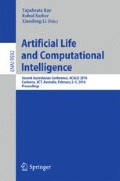Abstract
Performance issues when dealing with a large number of features are well-known for classification algorithms. Feature selection aims at mitigating these issues by reducing the number of features in the data. Hence, in this paper, a feature selection approach based on a multi-operator differential evolution algorithm is proposed. The algorithm partitions the initial population into a number of sub-populations evolving using a pool of distinct mutation strategies. Periodically, the sub-populations exchange information to enhance their diversity. This multi-operator approach reduces the sensitivity of the standard differential evolution to the selection of an appropriate mutation strategy. Two classifiers, namely decision trees and k-nearest neighborhood, are used to evaluate the generated subsets of features. Experimental analysis has been conducted on several real data sets using a 10-fold cross validation. The analysis shows that the proposed algorithm successfully determines efficient feature subsets, which can improve the classification accuracy of the classifiers under consideration. The usefulness of the proposed method on large scale data set has been demonstrated using the KDD Cup 1999 intrusion data set, where the proposed method can effectively remove irrelevant features from the data.
Access this chapter
Tax calculation will be finalised at checkout
Purchases are for personal use only
References
Bazi, Y., Melgani, F.: Toward an optimal SVM classification system for hyperspectral remote sensing images. IEEE Trans. Geosci. Remote Sens. 44(11), 3374–3385 (2006). 00252
Caruana, R., Freitag, D.: Greedy Attribute Selection, pp. 28–36. Citeseer (1994). 00536
Debie, E., Shafi, K., Lokan, C., Merrick, K.: Performance analysis of rough set ensemble of learning classifier systems with differential evolution based rule discovery. Evol. Intell. 6(2), 109–126 (2013). 00001
Elsayed, S.M., Sarker, R.A., Essam, D.L.: Multi-operator based evolutionary algorithms for solving constrained optimization problems. Comput. Oper. Res. 38(12), 1877–1896 (2011). http://www.sciencedirect.com/science/article/pii/S030505481100075X.00072
Frank, A., Asuncion, A.: UCI Machine Learning Repository. University of California, Irvine, School of Information and Computer Sciences (2010). http://archive.ics.uci.edu/ml
Gadat, S., Younes, L.: A stochastic algorithm for feature selection in pattern recognition. J. Mach. Learn. Res. 8, 509–547 (2007)
Garcia-Nieto, J., Alba, E., Apolloni, J.: Hybrid DE-SVM approach for feature selection: application to gene expression datasets, pp. 1–6. IEEE (2009)
Hall, M.A.: Correlation-based Feature Selection for Machine Learning. Ph.D. thesis (1999)
John, G.H., Kohavi, R., Pfleger, K.: Irrelevant Features and the Subset Selection Problem. In: Proceedings, pp. 121–129. Morgan Kaufmann (1994)
Khushaba, R.N., Al-Ani, A., Al-Jumaily, A.: Feature subset selection using differential evolution and a statistical repair mechanism. Expert Syst. Appl. 38(9), 11515–11526 (2011). http://linkinghub.elsevier.com/retrieve/pii/S0957417411004362
Kononenko, I.: Estimating attributes: analysis and extensions of RELIEF. In: Bergadano, F., De Raedt, L. (eds.) ECML-94. LNCS, vol. 784, pp. 171–182. Springer, Heidelberg (1994). http://dx.doi.org/10.1007/3-540-57868-4_57
Maimon, O., Rokach, L.: Improving supervised learning by feature decomposition. In: Eiter, T., Schewe, K.-D. (eds.) FoIKS 2002. LNCS, vol. 2284, pp. 178–196. Springer, Heidelberg (2002)
Mallipeddi, R., Suganthan, P.N., Pan, Q.K., Tasgetiren, M.F.: Differential evolution algorithm with ensemble of parameters and mutation strategies. Appl. Soft Comput. 11(2), 1679–1696 (2011)
Martinoyić, G., Bajer, D., Zorić, B.: A differential evolution approach to dimensionality reduction for classification needs. Int. J. Appl. Math. Comput. Sci. 24(1), 111 (2014). http://www.degruyter.com/view/j/amcs.2014.24.issue-1/amcs-2014-0009/amcs-2014-0009.xml
Oh, I.S., Lee, J.S., Moon, B.R.: Hybrid genetic algorithms for feature selection. IEEE Trans. Pattern Anal. Mach. Intell. 26(11), 1424–1437 (2004)
Price, K., Storn, R., Lampinen, J.: Differential Evolution: A Practical Approach to Global Optimization. Springer, New York (2005)
Raymer, M.L., Punch, W.F., Goodman, E.D., Kuhn, L., Jain, A.K.: Dimensionality reduction using genetic algorithms. IEEE Trans. Evol. Comput. 4(2), 164–171 (2000)
Storn, R., Price, K.: Differential evolution-a simple and efficient heuristic for global optimization over continuous spaces. J. Global Optim. 11(4), 341–359 (1997). 09676
Tasoulis, D.K., Plagianakos, V.P., Vrahatis, M.N.: Differential evolution algorithms for finding predictive gene subsets in microarray data. In: Maglogiannis, I., Karpouzis, K., Bramer, M. (eds.) AIAI. IFIP, vol. 204, pp. 484–491. Springer, New York (2006)
Tušar, T., Filipič, B.: Differential evolution versus genetic algorithms in multiobjective optimization. In: Obayashi, S., Deb, K., Poloni, C., Hiroyasu, T., Murata, T. (eds.) EMO 2007. LNCS, vol. 4403, pp. 257–271. Springer, Heidelberg (2007). http://dx.doi.org/10.1007/978-3-540-70928-2_22
Yu, L., Liu, H.: Feature selection for high-dimensional data: a fast correlation-based filter solution, pp. 856–863 (2003). http://citeseerx.ist.psu.edu/viewdoc/summary?doi=10.1.1.68.2975
Acknowledgement
This work was supported by the Australian Centre for Cyber Security Research Funding Program, under a grant no. PS38135.
Author information
Authors and Affiliations
Corresponding author
Editor information
Editors and Affiliations
Rights and permissions
Copyright information
© 2016 Springer International Publishing Switzerland
About this paper
Cite this paper
Debie, E., Elsayed, S.M., Essam, D.L., Sarker, R.A. (2016). Investigating Multi-Operator Differential Evolution for Feature Selection. In: Ray, T., Sarker, R., Li, X. (eds) Artificial Life and Computational Intelligence. ACALCI 2016. Lecture Notes in Computer Science(), vol 9592. Springer, Cham. https://doi.org/10.1007/978-3-319-28270-1_23
Download citation
DOI: https://doi.org/10.1007/978-3-319-28270-1_23
Published:
Publisher Name: Springer, Cham
Print ISBN: 978-3-319-28269-5
Online ISBN: 978-3-319-28270-1
eBook Packages: Computer ScienceComputer Science (R0)

